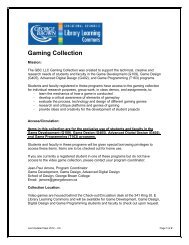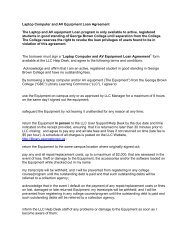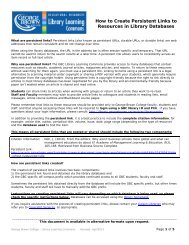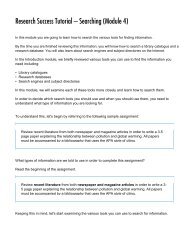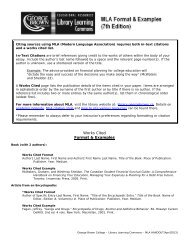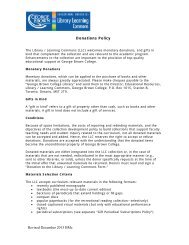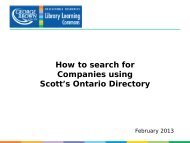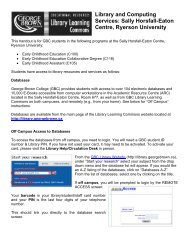summary - George Brown College Library Learning Commons
summary - George Brown College Library Learning Commons
summary - George Brown College Library Learning Commons
You also want an ePaper? Increase the reach of your titles
YUMPU automatically turns print PDFs into web optimized ePapers that Google loves.
Research Success Tutorial – Introduction (Module 1)<br />
In this module you are going to learn about:<br />
• different sources of information<br />
• various formats used for storing information<br />
• tools you can use for finding information<br />
Let's pretend you just got an assignment and you are wondering where to begin...<br />
You have lots of questions, like:<br />
• What kind of information do I need to complete the assignment?<br />
• Where can I look to find this information?<br />
• Once I have found everything I need, how do I put it all together in a way that makes sense?<br />
Different Sources of Information<br />
There are a number of places to look for information on your topic.<br />
Each of these is referred to as a source of information.<br />
Answers to your research questions will come from several different sources, including:<br />
Books<br />
A book is a volume made up of written pages that provides extensive<br />
coverage of a subject.<br />
Periodicals<br />
These are materials that are published on a continual basis: daily,<br />
weekly, monthly, yearly. Some examples are scholarly journals,<br />
popular magazines, newspapers.<br />
Non-Print Media<br />
This is information that does not use the written word to convey its<br />
message. Some examples are DVDs and CD-Roms.<br />
Web Sites<br />
These are pages of text and graphics arranged onto web pages located<br />
on the Internet.
Before you begin your research it is also important to know that information can be<br />
divided into two types...<br />
Primary Sources<br />
A primary source is an account by an eyewitness or the first recorder of an event, in written or other<br />
form. Examples include:<br />
• autobiographies<br />
• novels<br />
• diaries<br />
• letters<br />
• news footage<br />
• newspaper articles<br />
Secondary Sources<br />
A secondary source includes any material that interprets, restates, or analyzes a primary source.<br />
Examples include:<br />
• textbooks<br />
• encyclopedias<br />
• literary criticisms<br />
Hint: Many of the items found in libraries are secondary sources.<br />
Information Formats<br />
Information can appear in a variety of formats, including:<br />
Print – Books, Newspapers, Magazines<br />
Internet Based – Web sites, E-Books,<br />
Databases, which contain online journal, magazine and newspaper articles<br />
Non-Print Media – CD-ROMs, DVDs<br />
Sometimes, the same information can be found in more than one format. For example, the Toronto<br />
Star newspaper can be found in print and online format. Also, books can appear in both print and<br />
online formats.
Tools for Finding Information<br />
There are several different tools you can use to find information, which include:<br />
• <strong>Library</strong> catalogues<br />
<strong>Library</strong> catalogues are used to search for the titles and locations of items in your library such as books,<br />
e-books and DVDs.<br />
• Online research databases<br />
Research databases are used to search for information from sources such as journals, magazines,<br />
newspapers and e-books.<br />
• Search engines<br />
Search engines search through web sites on the Internet looking for matches to words you typed into the<br />
search box.



